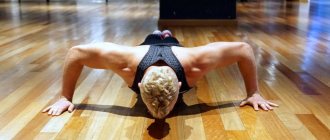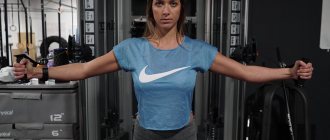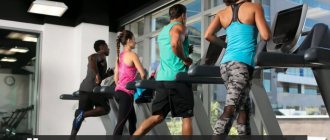Stretching the chest muscles is an important part of training for both men and women. In the first case, we work on the definition and beauty of the male pectoral muscle. In the second case, over muscle strength in women, so that the breasts are firm and toned. Moreover, stretching promotes faster muscle recovery, increases endurance, flexibility, a sense of control over your body, improves blood circulation, reduces muscle pain and relieves tension. As you can see, stretching is a very useful and even necessary part of training.
Before stretching, if you haven't worked out before, warm up your muscles to circulate blood through the muscles and thereby reduce the likelihood of injury. The simplest thing is to walk around, swinging your arms in different directions, and also rotate your shoulders. Always be careful when stretching, do not perform the exercises to the point of severe pain, at most to the point of slight discomfort. Today we offer you an effective, simple and affordable set of exercises for stretching the pectoral muscles.
Third exercise
- Sit on a chair, feet shoulder-width apart, back straight, shoulders straight.
- Place your hands behind your head, clasp your palms, keep your back straight, try not to move your neck.
- Gently try to straighten your elbows and thereby bring your shoulder blades together. While performing this exercise, you can feel a slight stretch in the chest muscles.
- Stay in this position for 15-30 seconds, while not forgetting to breathe deeply through your nose. Keep your neck as still as possible, despite the fact that you will want to change its position.
- This exercise is an excellent solution for office “plankton” who spend most of their lives at the computer.
Why do you need stretching?
To answer this question, we need to look at what happens to muscles during strength training. During work, muscle fibers contract. After completing the exercise, they remain compressed for some time. After training, the muscles can remain in this state for 24 hours. How does stretching help?
Stretching your muscles after exercise helps relax the muscle fibers and loosen them. Thus, the body needs less time to regenerate muscles, which means recovery will be faster. That is why, after strength training, it is advisable to perform several stretching exercises for the muscle group that was subjected to work.
Shoulder stretch
Chin retraction
Forward! Show off your double chin. This exercise is especially good for people who spend a long time in this position (i.e. sitting at the computer for eight hours a day). Pull your chin forward, then back, pressing it slightly into your neck. Try to keep your chin straight and parallel to the floor (without lifting it up or down). Repeat every hour 10 times.
Neck rotation
Tilt your head to the right and slowly, through the bottom (chin to chest) lead to the left shoulder (“drawing” the letter U). Then repeat in the opposite direction. Repeat 5 times in each direction. Rotate your neck only to the side and forward - not backward, as this will only increase the pressure in the chest.
Shoulder rotations
Standing straight, roll your shoulders up and back. Do about 10 reps. Then do 10 more reps on the other side, rotating your shoulders up and forward.
Neck stretch
Lean your right ear towards your right shoulder. Place your right hand above your left temple and, pressing lightly, “press” your head to your shoulder. The left hand is relaxed. Hold this position for 30 seconds, then repeat to your left shoulder.
Hands behind your back
Raise your right arm up, then bend it at the elbow and place your palm behind your head. Place your left hand behind your back and bend it at the elbow, resting the back of your hand on your right shoulder blade (or as close to the shoulder blade as possible). Grasp your right hand with your left hand. Repeat on the other side.
For those who find it very difficult: If you cannot reach the fingers of one hand with the other, use a towel.
Criss Cross Arm Stretch
Place your straightened right arm in front of your chest, pressing gently with your left hand to bring your right arm as close to your body as possible. Hold the position for 5-10 seconds, then rest and repeat for the other arm.
Shoulder rotation to stretch the rotator cuff
Lean your back against the wall, resting your shoulder blades against it. Bend both arms at a 90 degree angle. Without moving your shoulders, turn your right hand up so that the back of your hand touches the wall, and at the same time turn your left hand down, touching the wall with your palm (or as close as possible to the wall). Stay in this position for about 30 seconds.
Shoulder stretch against the wall
Place both hands on the wall at a 90-degree angle to your body. Step back until your arms are in line with your body. (Don't push the wall or let your arms get too high.)
Side neck stretch
Turn your head 45 degrees and look down towards your armpit. Reach your crown with your right hand, while keeping your elbow at an angle of 45 degrees (towards the armpit). The left hand can either be kept relaxed along the body or placed behind the back. Repeat the exercise 3 times on each side.
T, Y and I movements
Stand with your back against the wall. Slowly raise your arms straight out to the sides, forming a T. Then slowly raise your arms above your head so that your posture is first like a Y, then an I. Keep your shoulder blades pressed against the wall.
Palms locked on the lower back
Place your hands behind your back, thumbs toward the ground, and clasp your palms. Your palms should be in the lower back area. Extend your upper back slightly, expanding your chest and squeezing your shoulder blades together. Hold the position for 10 seconds, then do a reverse lock (if your left thumb was on top of the lock, fold your palms so that your right thumb is on top, and vice versa).
Rotation with straight arms
Stand perpendicular to the wall, slowly make a large circle with your straight arm. Stand as close to the wall as possible. Repeat 10 times in each direction, then turn your other side toward the wall and repeat the rotation with your other arm. Don't slouch or arch your back.
Reverse Prayer Pose
Place both hands behind your back and place your palms together as if you were praying, without moving your shoulder blades or slouching.
"Thread the Needle"
Get on all fours. Lift your left arm off the ground and slide your left palm into the space between your right arm and right leg. Allow your upper body to naturally follow your hand. Stop when your hips begin to move.
Sphinx pose with arms outstretched
Lie on your stomach, arms by your sides, palms on the floor in the chest area. Lift your chest off the floor, keeping your arms motionless, and bend your back (keep your lower back relaxed). Lift your right arm off the floor and raise it so that your bicep is as close to your ear as possible. Hold for 5 seconds, slowly lower your arm and repeat on the other side.
Rotation of the thoracic region for stretching
Lie on your right side with your legs slightly bent. Stretch your arms in front of you, your left hand placed on your right. Slowly raise your left arm up and back. Move your arm back as far as possible, keeping your hips still. Slowly turn your head to the left, watching your left hand. Stay in this position for a few seconds and return back. Repeat 10 times on each side.
Based on materials:
https://greatist.com/move/stretches-for-tight-shoulders
How to warm up before shoulder stretching
Before performing any exercises, including those aimed at stretching the shoulders, you must first warm up the muscles - this will help minimize the risk of injury.
To do this, you will need to do one of the simple steps below:
- extend your arms in front of you and move them back and to the sides so that your body resembles the letter T;
- take a warm shower;
- run in place for several minutes;
- perform “feet together, feet apart” jumps.
Before performing any exercises, including those aimed at stretching the shoulders, you must first warm up the muscles.
After warming up, you can begin to perform simple shoulder stretching exercises.
Triceps stretch
Stretching the triceps, as in the case of the biceps, promotes the growth of this muscle. Do not forget that the triceps give the main volume to the arm (70% of the volume), which is why this muscle should be well worked out.
Triceps stretching exercises look like this:
- For the first exercise you will need equipment, namely a towel. Take it in one hand and place it behind your head so that your thumb points toward the floor. Place your free hand behind your back and grab the towel. Pull the towel down and you should feel a stretch in your triceps. Complete this exercise for both hands and proceed to the next one.
- No equipment is required for this exercise. While standing or sitting, place your hand behind your head, grab your elbow with your free hand and pull it towards your head. Hold your hand in this position for 5-10 seconds.
- Place your left hand on your right shoulder. With your right hand, grab your elbow and push your left arm toward your body. Then switch hands.
Rules for stretching
To get additional benefits from exercise and to reduce the likelihood of injury, it is recommended:
- Start the lesson with a warm-up. The muscles and ligaments need to be warmed up, then they will stretch better.
- Stretch the entire body sequentially, starting with the neck, shoulder girdle, chest and back, ending with the leg muscles.
- When performing static stretching, which is recommended for an untrained person, hold the body position at the maximum point of stretching for at least 30 seconds.
- stop if a slight tingling occurs;
- pay special attention to proper breathing. It should be deep and measured.
Stretching should be stopped immediately if:
- strong pain;
- muscle spasm;
- dizziness;
- crunching or clicking in the joints.
It is better to move on to stretching the shoulder girdle immediately after stretching the neck. To do this, you can make smooth turns and tilts of your head or, with light effort, alternately pull your head with your hands to your shoulder.
What is stretching
Stretching or stretching is a set of exercises aimed at increasing muscle elasticity, thereby increasing strength, endurance and flexibility of the body, as well as strengthening muscles and joints.
Stretching, first of all, is necessary to prevent injuries when playing sports. According to the rules, before starting a workout, a warm-up is carried out, and after a short rest - stretching. It is designed to help the body adapt to stress. After finishing the workout, a set of final stretching exercises is performed - a cool-down. It allows you to relieve overstrain from the muscles and cool them down. After stretching, blood flow in the tissues increases, which means their supply of oxygen and nutrients improves.
Stretching helps relieve muscle pain.
First exercise
- Find an empty corner in the room, stand in it and rest your leading foot, leaning slightly forward. The driving leg should be closest to the corner, the back should be straight, and the chest muscles should be tense. This exercise is great for people suffering from muscle pain after a long workout, office work,
- Place your left hand on the wall on the left, and your right hand on the right, at a distance of 70-80 cm from each other. With your back straight, feet shoulder-width apart, take a deep breath.
- Bend the front leg that is in the corner, move your body forward so that your head is also in the corner. The posture is straight, the back is at an angle of 30 degrees, the neck is motionless.
- Freeze in this position for half a minute, take a deep breath and try to squeeze your shoulder blades together. You will immediately feel a feeling of tense chest muscles.
Shoulder stretch
Stretching the shoulders, in the absence of problems with the spine, can transform a stooped, hunched person into a person with excellent posture. Also, exercises to increase flexibility in the muscles of the shoulder girdle help improve blood circulation in the upper body and make breathing easier.
You can stretch your shoulders as follows:
- One of the simplest exercises: press your right hand as close as possible to your left shoulder, with your left hand you can press your right hand near the elbow. Switch hands and do it again.
- An effective exercise to improve the flexibility of the shoulder girdle is performed as follows: you need to put one hand behind your head and the other behind your back and try to lock them together as much as possible. Stay in this position for 10 seconds and switch hands. If you have problems with posture, then this exercise may not work for you. You'll have to stretch your arms one at a time.
- Stand facing the wall, rest your hands on it. Place your hands as close to each other as possible. Move your feet away from the wall as far as possible. Lower your head down and bend in the lumbar region. You will feel a stretch in your shoulders, chest and spine.
Perform the exercises presented every time after strength training. If you purposefully train flexibility, do them at least 3 times a week. Then the result will not be long in coming. Alternate exercises, combine them with others.
Try to develop the flexibility of all muscles at the same time - this will significantly reduce the risk of injury during sports.
Stretching after training
It is known that after any intense workout, when the muscles are tense and warm, you need to stretch.
This will relieve tension and quickly return muscle tissue to normal. Stretching the pectoral muscles after training can be done using the exercises described above or using exercise machines. An expander would be best for this purpose. Depending on the level of training, the rigidity and design of the simulator are selected. As a rule, they include not only instructions, but also exercise techniques. Training with an expander is easy, effective and safe.
In order not to harm the body, all exercises must be performed carefully, starting with minimal load and gradually increasing it.
Adviсe
- You should not stretch if your muscles are not warmed up. Of course, if the exercise is done after training, then this point can be removed, but if it is performed on a separate day, then you should warm up thoroughly, otherwise you may get injured.
- You should do no more than two stretching exercises per muscle group after training. The best option is one exercise after training for a specific group for 20-30 seconds.
- Stretching the pectoral muscles can be very painful. If there is pain during stretching, it is better to stop doing the exercise or loosen the tension so as not to get injured.
Why shoulder stretching is necessary for every person
The shoulder joint is the most mobile joint in the body, which is why it is at higher risk of injury and pain. Moreover, this joint is connected to the neck, ribs and scapula.
The shoulder joint is the most mobile joint in the body, which is why it is at higher risk of injury and pain.
For these reasons, shoulder stretches are not only necessary for people with sedentary jobs. When carrying a heavy bag or backpack, many people do not notice how much their body position changes. Thus, to avoid overstraining the shoulder muscles and prevent the occurrence of pain, it is necessary to regularly perform:
- warm-up before shoulder stretching;
- Shoulder stretching exercises.
Pectoral muscles
The chest is a fairly large muscle group, so it can take a long time to recover after a workout. Stretching the pectoral muscles after training will help improve the quality of recovery, as well as reduce the time spent on regeneration.
The chest is actively worked in the following exercises:
- Bench press.
- Raising arms on an incline bench.
- Dips.
- Pushups.
- Bringing your hands together in a crossover.
If the workout consists of exercises that primarily involve the chest, then all parts of it should be stretched. Below are exercises that will help you do this.










